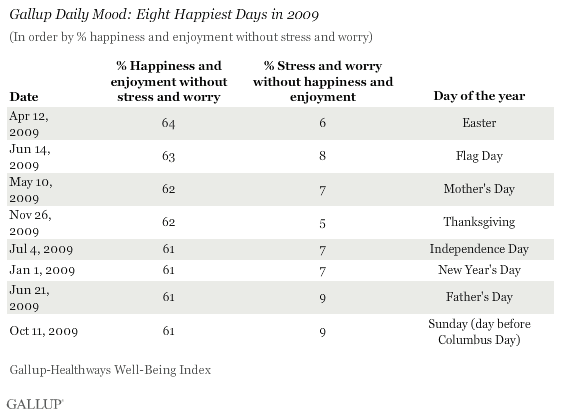WASHINGTON, D.C. -- The percentage of Americans experiencing a lot of happiness or enjoyment without a lot of stress or worry declined slightly from an average of 48.2% in 2008 to 47.4% in 2009, according to data from the Gallup-Healthways Well-Being Index. Conversely, the percentage of Americans experiencing a lot of stress or worry but not a lot of happiness or enjoyment increased by about the same amount.

The surveys a random sample of at least 1,000 adults 350 days out of the year, or at least 350,000 adults each year, on a wide range of topics related to health and wellbeing. One of the questions asked each day is "Did you experience a lot of the following yesterday?" The question inquires about several personal experiences, including happiness, enjoyment, stress, and worry. Data are then compiled to determine the percentage of respondents who experience a lot of happiness and enjoyment each day but not a lot of stress and worry, and vice versa.
The Daily Mood Index: 2009's Happiest Days
Americans' happiest days of 2009 were on or close to holidays, consistent with previous mood index scores showing that days with more-than-normal time dedicated to socializing with family and friends enhance people's happiness and enjoyment. Thanksgiving, 2008's happiest day, slipped slightly to fourth place in 2009, replaced by 2008's runner-up, Easter Sunday. Flag Day (June 14), which did not make the list last year, was the second happiest day in 2009, while Mother's Day and Independence Day made the top five each year. As Flag Day is not a holiday that typically calls for any sort of out-of-the-ordinary celebration, it is important to note that it is possible that a day could rise to the top of the list without an obvious catalyst, which may be the case for June 14.
This year, there is not a measure for Christmas Day as a major snowstorm that affected much of the country closed Gallup's interviewing centers Dec. 26, but Christmas was the third happiest day in 2008.

The Daily Mood Index: 2009's Most Stressful and Worrisome Days
As in 2008, the most stressful and worrisome days for Americans in 2009 tended to occur on or close to days when the nation was experiencing significant economic trials. On Jan. 29, Americans experienced the most stress and worry without happiness and enjoyment -- the day after the U.S. House of Representatives passed the emergency economic stimulus bill. The day the bill passed (Jan. 28) and two days after the bill's passage (Jan. 30) also made the list of the eight most stressful and worrisome days of the year.

Less than a month later, amid news of the U.S. government taking over nearly 40% of Citigroup's common stock and with the Dow Jones industrial average falling to its lowest level in nearly 12 years, Americans' collective stress level rose to the second highest point of 2009 on Feb. 23. The following day, President Obama spoke in a highly anticipated joint session of Congress, focusing heavily on the seriousness of the global recession.
Included in the top eight most stressful and worrisome days of 2009 was one of the leading popular interest stories of the year, the July 7 memorial service for Michael Jackson, which finished third on the list. (June 25, the day of Jackson's death, was the 31st most stressful and worrisome day of the year.) Coinciding with Jackson's service was news reporting that on July 8 seven U.S. troops were killed in Afghanistan, the deadliest day for U.S. forces in nearly a year.
It's important to note that it is not possible based on daily events to definitively determine the cause of unusual increases in stress and worry compared with normal levels. The events described in this article are simply noted to coincide with high stress/worry days as a potential source of effect on Americans' mood.
Learn more about the .
Survey Methods
Results are based on annual samples that are greater than 350,000 per year and on daily sample sizes that are at least 1,000 per day. For annual results based on the total sample of national adults, one can say with 95% confidence that the maximum margin of sampling error is ±0.2 percentage point. Daily samples carry a maximum margin of sampling error of ±3 percentage points.
Interviews are conducted with respondents on landline telephones (for respondents with a landline telephone) and cellular phones (for respondents who are cell phone only and cell phone mostly).
In addition to sampling error, question wording and practical difficulties in conducting surveys can introduce error or bias into the findings of public opinion polls.
About the Gallup-Healthways Well-Being Index™
The Gallup-Healthways Well-Being Index measures the daily pulse of U.S. wellbeing and provides best-in-class solutions for a healthier world. To learn more, please visit .
